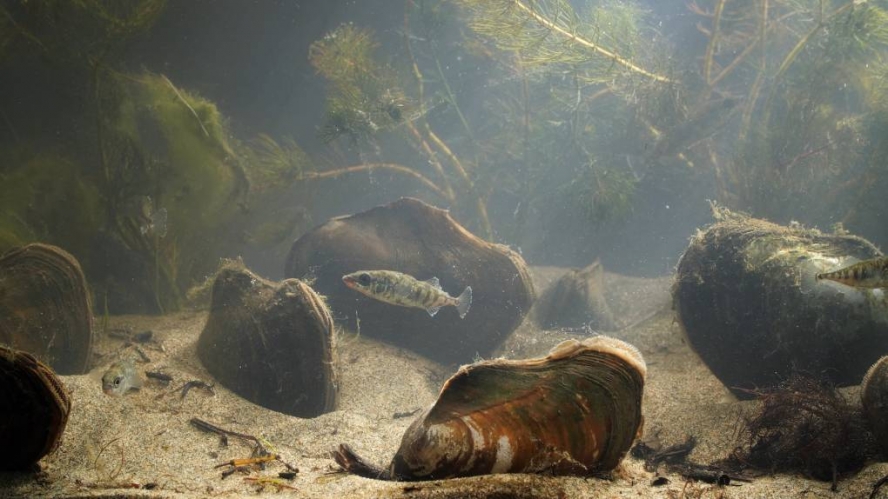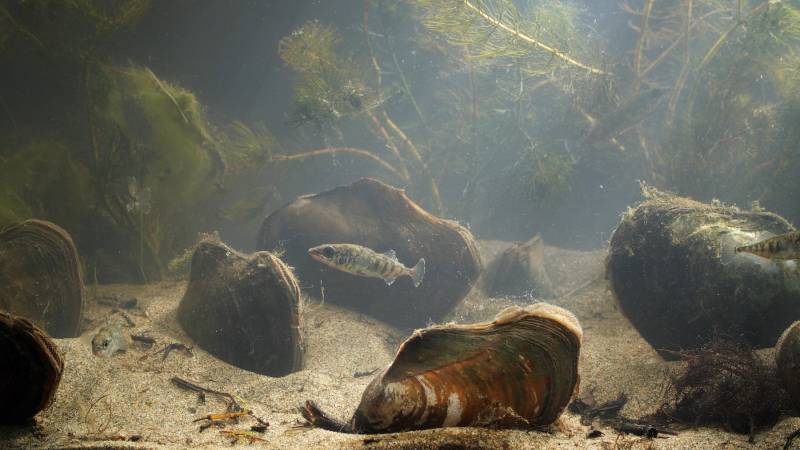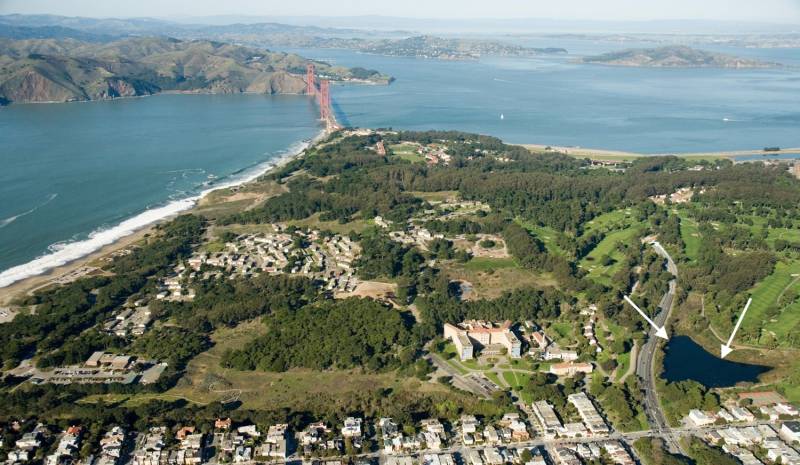
California Floater Mussels Take Fish for an Epic Joyride
Apr 21, 2020 at 12:55pm
Ecologist Jonathan Young steered his rowboat alongside a rectangular container that was floating between two bright orange buoys. He reached under a plastic mesh covering and pulled out a large black and brown object the size of his fist that looked a lot like a clam.
“These are the underdogs of water quality,” he said. “And also, unfortunately, on their way to extinction.”
Young is part of a team that is reintroducing the California floater mussel, a native freshwater mussel, and other native plants and animals, to Mountain Lake — a tiny 2,000-year-old natural lake located on the southern edges of San Francisco’s Presidio, nestled between the Presidio Golf Course, the Lake Street neighborhood and Park Presidio Boulevard.

The mussels, which naturally filter water and clean it, are a key part of an ambitious restoration project run by the Presidio Trust, a federal agency set up by Congress to help oversee the former military base with the National Park Service.
The California floater is just one of about 300 species of native freshwater mussels in North America, approximately two-thirds of which are threatened, endangered or species of special concern. One thing that often distinguishes them from their saltwater cousins is that most species need a host fish to live off of before they develop fully. It is a fascinatingly clever survival method, but also one of the main reasons their existence is threatened now. In lakes and waterways where the fish populations have disappeared, the mussels have no way to grow in number.
Before European settlers arrived in the late 18th century, California floater mussels were likely one of several species found in Mountain Lake, where native Ohlone people would gather food. Things began to change drastically when Spain, and then Mexico, established military bases in the Presidio. The U.S. Army took over in 1848 and maintained a military presence until 1994 when the site transferred to the National Park Service.
In 1938, when the Golden Gate Bridge was completed, the military only allowed the connecting highway to go under its golf course, and over a section of Mountain Lake. So highway engineers built a tunnel next door, filling in almost half of the lake to build the access roadway from the bridge to the city.
Over the years, the water quality and ecological balance of the lake has been significantly altered by urban activities. Millions of pounds of fertilizer used on the golf course introduced an imbalance of nutrients. For decades, toxic lead and other automobile contaminants drained directly from the roadway into the lake. Most likely due to the resulting filthy water and imbalance in the habitat, the sensitive native mussels have not naturally been found in the lake for quite some time, scientists say.

It wasn’t until 2011, when the federal government ordered Caltrans to pay $13.5 million to clean up the lake, that the possibility of restoring the mussels’ home could begin in earnest. In 2013, 17,500 cubic yards of contaminated sediment — enough to fill 1,750 dump trucks — was removed from the 4-acre lake, and the Presidio Trust put together a comprehensive plan to resurrect it.
Since 2014, Mountain Lake, its surrounding wetland and coastal scrub habitats have been the site of a large-scale ecological restoration project of native plants and animals. The goals are to improve water quality, increase biodiversity and promote public awareness in San Francisco and beyond.
In addition to the California floaters, the list of reintroduced native animal species now includes Three-spined stickleback fish, Western pond turtles, Pacific chorus frogs, California red-legged frogs and the San Francisco forktail damselfly. Reintroduced native plants include Common mare’s tail, Floating pond weed, Sago pond weed and Coon’s tail.
The small, sparkly three-spined stickleback fish in the lake were relocated from nearby Lobos Creek. They happen to play a critical role in the mussel’s life cycle. The mussels have evolved an ingenious method of launching their larvae, or glochidia, into the water, where they clamp onto a fish gill or fin. The larvae hitch a ride on the fish for a few weeks, absorbing nutrients from their hosts, until they are ready to drop off and begin life as a young mussel on the lake bed.
With the guidance of biologist Chris Barnhart of Missouri State University, Young and his team have developed a system to help grow the mussel population in the lake and for successfully raising juvenile mussels in the lab. The biologists borrow adult mussels for a few days at a time and bring them back to a lab where they put them in small tanks with the stickleback fish. Once enough of the stickleback carry glochidia on their gills and fins, Young puts them and the mussels back into the lake.
If they’re lucky, the larvae on the fish will make it to the juvenile stage and grow up to be hardworking living water filters.
Read more of the original article here.
